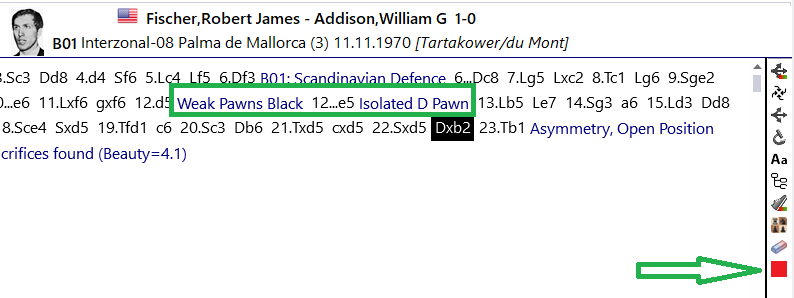|
Criteria of the Style Report |

|

|
|
|
Criteria of the Style Report |

|

|
Criteria of the Style Report
Below is a list of the key criteria that the program takes into account and evaluates for the Style Report.
• Success: Determined by the points scored in the analyzed games. Stronger players do not necessarily have higher success rates, as their opponents are also stronger.
• Theory: Factors include the average evaluation after the opening (e.g., the advantage White gains from the opening), the average length of theoretical lines, and the breadth of the repertoire. Main lines are preferred; however, the "modernity" of the repertoire is not considered.
• Decisive Games: The pure draw rate, weighted differently for White and Black. Draws with White are weighted more heavily.
• Fighting Spirit: Not measured by draw rate alone, as hard-fought draws reflect high fighting spirit. The rate of short draws, the average length of drawn games, and willingness to make or accept exchange offers are also considered. Sharpness and aggression are not included, as one can show high fighting spirit purely through positional play.
• Aggressiveness: Frequency of strong attacks on the king, successful sacrifices, early pawn sacrifices or gambits, and avoidance of queen exchanges.
• Risk: Measured by sharpness and complexity in games, use of sharp openings or gambits, asymmetrical structures, and asymmetrical material configurations.
• Positional Play: Active piece play, strong pieces and squares, bishop pair, avoidance of pawn weaknesses, provocation of opponent's pawn weaknesses, play for space advantage, play on the queenside or in the center, and siege of weaknesses. Use of a fianchettoed white bishop and openness to closed or quiet positions are also factors.
• Endgame Skill: Frequency of endgames in analyzed games, above-average success across various endgame phases, resistance in endgames with material disadvantage, and successful conversion of material advantage. No tendency to avoid exchanges.
The percentages in the evaluations and labels such as "high," "normal," etc., refer to average values from grandmaster comparison games.
Tip: When you load a game from the thematic games, use the red quick-comment toggle to receive significant themes as text annotations.

When calling up the style report via the player index, you can limit the years to be analyzed. Many players change their style over time. For example, Paul Keres was a bold attacker in his youth but later adopted a more positional and controlled playing style.
The style report operates with minimal engine calculations, making it extremely fast. It processes at a rate of several seconds per 1,000 games. As a result, it does not assess tactical accuracy; this is handled by the slower error report.
Analyzing Multiple Players
Tip: You can analyze multiple players at once. Sort the player index of a database, for example, by number of games or Elo rating, so that prominent players appear at the top.
Select multiple players -> Style Report